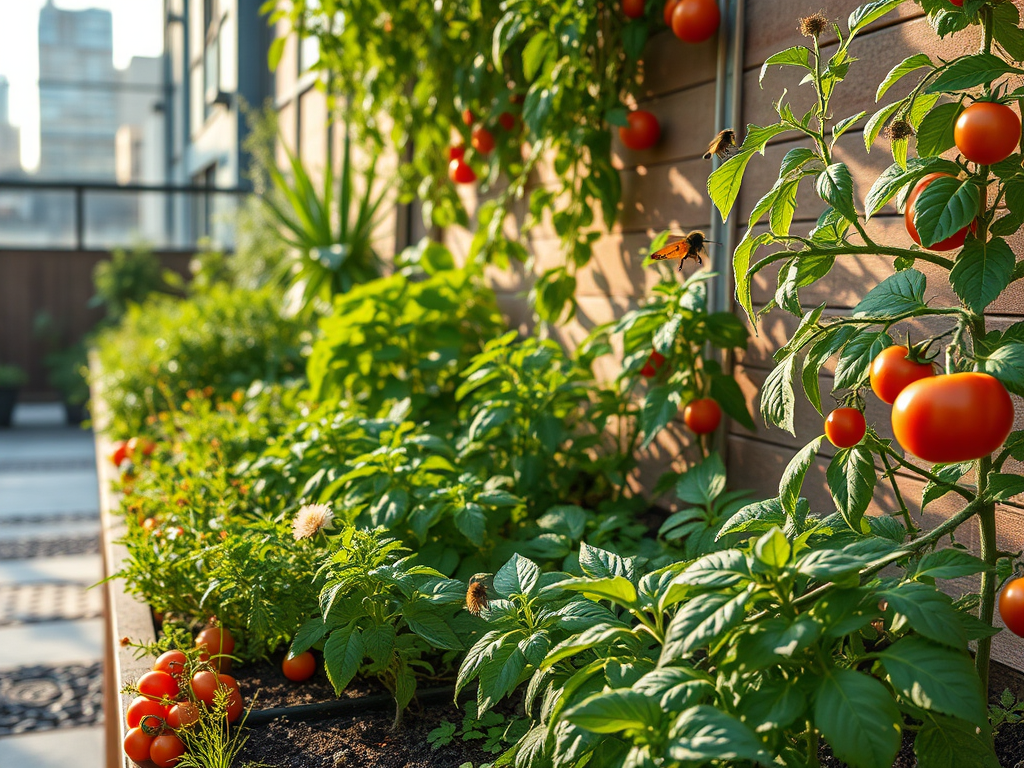Urban permaculture is a sustainable design approach that transforms city spaces—backyards, rooftops, balconies, and community gardens—into productive, eco-friendly ecosystems. By mimicking natural systems, permaculture promotes food security, biodiversity, and resource efficiency, even in densely populated areas. One of the most critical elements of a thriving urban permaculture system is water.
In cities, water scarcity is a growing concern due to climate change, over-extraction of groundwater, and aging infrastructure. Many urban gardeners rely on municipal water, which can be expensive, chemically treated, and unsustainable in the long run. A self-sufficient water system not only reduces dependency on external sources but also conserves this precious resource while supporting a resilient permaculture garden.
This article explores practical ways to design and implement a closed-loop water system for urban permaculture, covering:
- Rainwater harvesting – Turning runoff into a reliable water source.
- Greywater recycling – Reusing household water for irrigation.
- Swales and earthworks – Retaining water in the landscape.
- Aquaponics and hydroponics – Water-efficient growing methods.
- Smart irrigation – Minimizing waste with efficient watering techniques.
Whether you’re an urban homesteader, a balcony gardener, or a community project organizer, these strategies will help you create a sustainable, water-wise permaculture system that thrives even in the heart of the city. Let’s dive in!
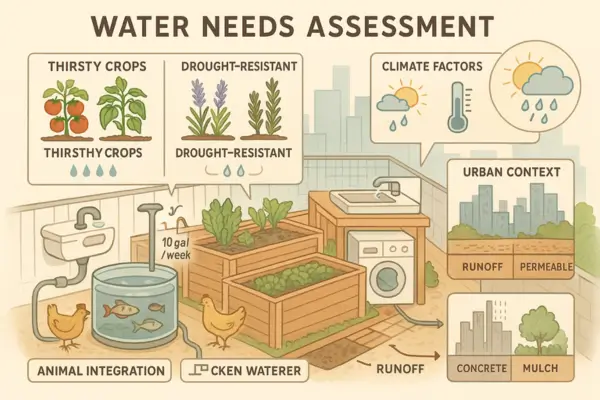
Understanding Water Needs in Urban Permaculture
Before designing a self-sufficient water system, it’s essential to assess how much water your urban permaculture project actually requires. Water needs vary depending on factors like plant types, garden size, local climate, and whether you’re integrating animals or aquaculture.
Assessing Water Requirements
- Plants: Different species have different hydration needs—leafy greens and vegetables generally require consistent moisture, while drought-resistant perennials (like herbs and native plants) need less.
- Animals (if applicable): Chickens, bees, or aquaponic fish all need clean water, which must be factored into your system.
- Household Use: If you’re incorporating greywater recycling, consider how much water comes from sinks, showers, and laundry.
Calculating Water Usage
A simple way to estimate water needs is:
- Garden Size: Measure your growing area (in square feet/meters).
- Climate & Evaporation Rates: Hotter, drier climates require more frequent watering.
- Rainfall Patterns: Track seasonal rainfall to determine how much supplemental irrigation is needed.
For example, a 100 sq ft garden in a Mediterranean climate might need 10-15 gallons per week in summer but far less in rainy seasons.
Why Water Conservation Matters in Cities
Urban areas face unique challenges:
- Limited Space: Small gardens mean every drop counts.
- Runoff Waste: Paved surfaces prevent rainwater absorption, increasing dependency on municipal supplies.
- Regulation Restrictions: Some cities limit rainwater collection or greywater use, making efficiency crucial.
By accurately assessing your water needs and optimizing usage, you can design a system that minimizes waste while keeping your permaculture garden thriving.
Next Up: Rainwater Harvesting—how to turn every downpour into a valuable resource!
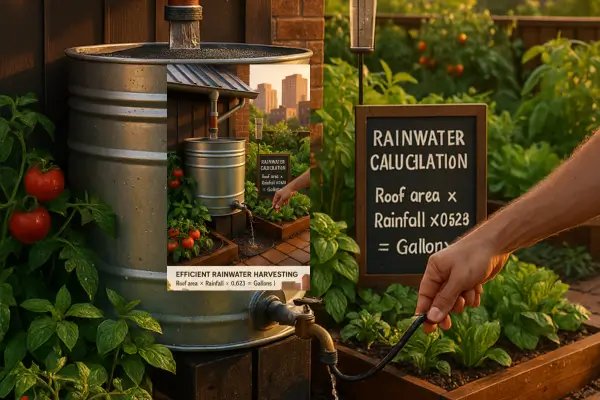
Rainwater Harvesting: The Foundation of Self-Sufficiency
In urban permaculture, rainwater harvesting is one of the most effective ways to create a sustainable water supply. Unlike municipal water, rainwater is free, soft (low in minerals), and ideal for plants. By capturing and storing rainfall, you can reduce your environmental impact while building resilience against droughts and water restrictions.
Benefits of Rainwater Harvesting for Urban Permaculture
- Reduces water bills by supplementing or replacing tap water for irrigation
- Improves plant health (rainwater is chlorine-free and slightly acidic, which many plants prefer)
- Decreases stormwater runoff, reducing urban flooding and erosion
- Provides a backup supply during water shortages or restrictions
Components of a Rainwater Collection System
A well-designed system includes:
1. Roof Catchment Systems
- Your roof acts as the primary collection surface.
- Best materials: Metal, tile, or slate roofs (avoid treated wood or asphalt shingles, which can leach chemicals).
- Calculate collection potential:
- Formula: *Roof area (sq ft) × Rainfall (inches) × 0.623 = Gallons collected*
- Example: A 500 sq ft roof in an area with 1″ of rain yields ~300 gallons.
2. Gutters and Downspouts
- Direct water from the roof to storage.
- Use leaf guards to minimize debris.
- Slope gutters properly (1/4″ per 10 ft) for optimal flow.
3. Storage Tanks (Barrels, Cisterns)
- Barrels (50-100 gallons): Good for small spaces (balconies, tiny yards).
- Large cisterns (500+ gallons): Ideal for serious permaculture projects.
- Placement: Elevate barrels for gravity-fed irrigation; bury cisterns to save space.
- Materials: Food-grade plastic, stainless steel, or ferrocement.
4. First-Flush Diverters and Filtration
- First-flush system: Discards the initial rainwater (which may contain roof debris, bird droppings).
- Basic filtration: Mesh screens, sand filters, or activated charcoal for cleaner water.
- For potable use: Requires advanced UV or ceramic filtration.
Legal Considerations in Urban Areas
- Some cities restrict rainwater harvesting (e.g., Colorado had bans; now regulated but allowed).
- Check local codes for:
- Tank size limits
- Mosquito control requirements (covered tanks, screens)
- Greywater/rainwater use permits
- Homeowners’ associations (HOAs) may have additional rules.
Getting Started
Start small with a single rain barrel and expand as needed. Even a basic system can supply hundreds of gallons annually—enough to keep an urban garden thriving through dry spells.
Next Up: Greywater Recycling—how to safely reuse household water in your permaculture system!
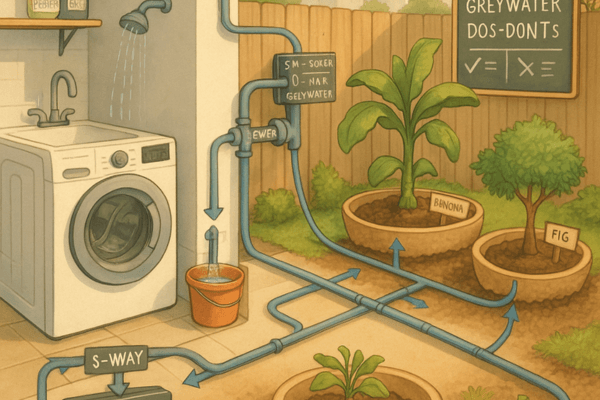
Greywater Recycling: Maximizing Water Reuse
While rainwater harvesting captures nature’s supply, greywater recycling puts your household’s used water back to work. In urban permaculture, reusing greywater can significantly cut freshwater demand while nourishing plants—turning waste into a resource.
What Is Greywater?
Greywater is gently used water from:
✔ Showers & bathtubs
✔ Bathroom sinks
✔ Washing machines
✔ (Sometimes) kitchen sinks*
*Kitchen water (especially with grease/oils) is often considered “dark greywater” and requires extra treatment.
Why Use It?
- Saves 30-50% of household water by redirecting it to irrigation.
- Reduces strain on septic/sewer systems.
- Provides nutrients (mild soaps add phosphorus, potassium).
Simple Greywater Systems for Urban Homes
1. Laundry-to-Landscape (L2L) System
Best for: Beginners; no plumbing changes needed.
How it works:
- Washing machine pump directs water to mulch basins around trees/gardens.
- Requirements:
- Biodegradable, low-sodium detergent
- 1″ distribution tubing with drip emitters or mulch basins
- Gravity flow (or a pump if uphill)
Pros: Cheap, DIY-friendly.
Cons: Only works when running laundry.
2. Kitchen Sink Filtration (For Greywater-Safe Soaps)
Best for: Small-scale herb gardens.
Methods:
- Bucket method: Collect rinse water manually for spot-watering.
- Branched drain system: Pipes direct water through a grease trap/gravel filter to garden beds.
⚠ Avoid: Meat/fat-heavy water (compost instead).
3. Shower & Bathroom Sink Reuse
Options:
- Gravity-fed branched drain: Diverts water via 1.5″ pipes to mulch basins.
- Pumped system: Small sump pump sends water to raised beds.
- Humanure hybrid: Composting toilets can integrate with greywater for full-cycle systems.
Safety Precautions & Best Practices
Greywater is safe if managed properly, but follow these rules:
✔ Use plant-friendly soaps (no boron, chlorine, or synthetic fragrances).
✔ Avoid standing water—always drain into mulch or soil (prevents mosquitoes).
✔ No root crops—irrigate fruit trees/ornamentals, not lettuce/carrots.
✔ Rotate distribution—prevent salt buildup by alternating zones.
✔ Local codes: Some areas require permits (especially for indoor plumbing modifications).
Start Small, Scale Wisely
A simple laundry-to-landscape system can save hundreds of gallons monthly. Pair it with rainwater harvesting for a truly closed-loop urban oasis.
Next Up: Designing permaculture swales to maximize water retention in city spaces!
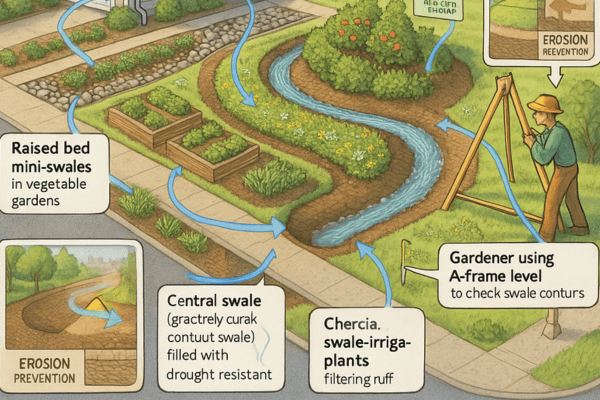
Designing a Permaculture Swale and Water Retention Landscape
In urban permaculture, every drop of water counts—and earthworks like swales and berms are game-changers for maximizing hydration in small spaces. These features slow, spread, and sink water into the landscape, turning runoff into a resource rather than waste.
How Swales & Berms Retain Water in Urban Gardens
A swale is a shallow, vegetated ditch dug along the land’s contour, while a berm is the mounded soil piled downhill from it. Together, they:
✔ Capture rainwater runoff (from roofs, paved areas, or slopes).
✔ Recharge groundwater by allowing water to infiltrate slowly.
✔ Prevent erosion in sloped urban lots.
✔ Support plant roots with consistent moisture, reducing irrigation needs.
Urban Adaptations:
- Mini-swales (1-2’ wide) work in tiny yards or raised beds.
- Rooftop swales (using lightweight soil) manage balcony runoff.
- Parking strip swales curb street flooding while irrigating street trees.
Keyline Design: Smarter Water Distribution
Developed by Australian farmer P.A. Yeomans, Keyline principles optimize water flow:
- Follow Contours—Swales should always be level (use an A-frame or laser level).
- Prioritize High Points—Place swales just below ridge lines to catch water early.
- Grade Slightly—Channel overflow to the next swale (1% slope max).
Urban Example:
On a 30’ backyard slope:
- Dig a swale along the midpoint contour.
- Plant drought-resistant trees (e.g., figs, olives) on the berm.
- Overflow feeds a rain garden or cistern.
Creating Microclimates with Earthworks
Water-harvesting earthworks transform harsh urban spots into lush zones:
🌱 Sunken Gardens: In dry climates, depressions collect dew and rain.
🌳 Windbreak Berms: Soil mounds + shrubs shield plants from drying winds.
💦 Sponge Beds: Woody mulch in swales boosts microbial moisture retention.
Pro Tip:
Pair swales with dynamic accumulators (comfrey, yarrow) to cycle nutrients from deep soil layers.
Getting Started
- Observe Your Site: Watch how water flows during rain.
- Start Small: A single swale behind a garage can hydrate fruit bushes.
- Avoid:
- Swales near foundations (keep 10’ away).
- Compacted urban subsoil—loosen with a broadfork first.
Next Up: Aquaponics—the ultimate water-looping system for city growers!

Integrating Aquaponics and Hydroponics for Water Efficiency
In water-scarce urban environments, aquaponics and hydroponics offer revolutionary ways to grow food with minimal water waste. These soil-less systems recirculate water continuously, using up to 90% less water than traditional gardening—making them perfect for urban permaculture.
Closed-Loop Aquaponics: The Ultimate Water-Saving System
Aquaponics combines aquaculture (fish farming) with hydroponics (soilless plant growing) in a symbiotic cycle:
- Fish waste → Provides natural fertilizer (ammonia) for plants.
- Plants + Bacteria → Filter and clean the water.
- Clean water → Recirculates back to the fish.
Why It’s Perfect for Urban Permaculture:
✔ Uses 1/10th the water of soil gardening (no evaporation or runoff).
✔ Grows fish + veggies in small spaces (balconies, rooftops, basements).
✔ No synthetic fertilizers—nutrients come from fish feed.
Example: A 50-gallon tank with tilapia can support a 4 sq ft grow bed of lettuce, herbs, and strawberries—using just 5-10 gallons per week (vs. 50+ gallons in soil).
Hydroponics: Precision Watering for City Growers
Hydroponics grows plants in nutrient-rich water (no soil). Key benefits:
✔ Faster growth (roots access nutrients directly).
✔ No weeding or soil pests.
✔ Up to 90% less water (recirculating systems lose almost none).
Best Urban Hydroponic Methods:
- Deep Water Culture (DWC): Plants float on oxygenated water (great for lettuce).
- Nutrient Film Technique (NFT): Thin water film flows through pipes (ideal for herbs).
- Wick Systems: Passive, low-tech (best for small spaces).
Combining with Rainwater + Greywater
To maximize sustainability:
- Rainwater Harvesting → Use stored rain to top up fish tanks/hydroponic reservoirs.
- Greywater Recycling → Filtered shower/sink water can supply hydroponics (if soap-safe).
- Aquaponics Overflow → Drain nutrient-rich water into swales or compost piles.
Urban Hybrid System Example:
- Rainwater fills the aquaponics fish tank.
- Greywater (from laundry) irrigates a wicking bed of water-loving plants (bananas, taro).
- Condensate from AC units supplements hydroponic reservoirs.
Getting Started
🔹 Small-Scale: Try a 10-gallon aquaponic herb kit (no plumbing needed).
🔹 DIY Option: Convert an IKEA shelf into an NFT hydroponic system.
🔹 Avoid: Overstocking fish (1 gallon per inch of fish) or overfeeding (causes algae).
Next Up: Smart Irrigation—how to automate watering while saving every drop!
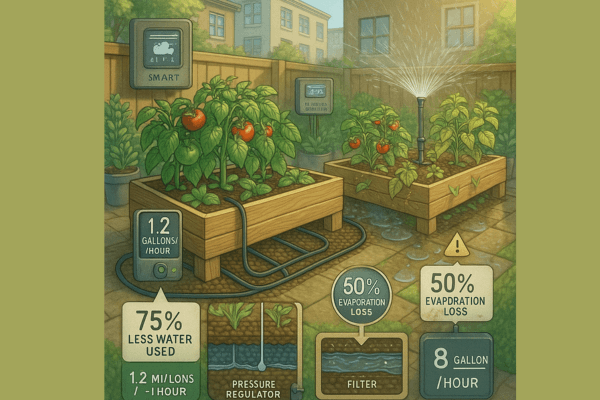
Smart Irrigation and Water-Saving Techniques
In urban permaculture, every drop of water matters—especially during hot summers or droughts. Smart irrigation ensures your plants get exactly what they need, without waste. Here’s how to optimize watering efficiency in small spaces.
Drip Irrigation vs. Overhead Watering: Which Is Best?
Drip Irrigation (The Gold Standard)
- How it works: Delivers water directly to plant roots via tubes and emitters.
- Best for:
- Vegetable beds, fruit trees, and container gardens.
- Sloped or windy urban spaces (minimizes runoff).
- Pros:
✔ Saves 30-50% more water than sprinklers.
✔ Reduces fungal diseases (no wet leaves).
✔ Can be automated with timers.
- Cons:
✖ Requires setup (but DIY kits are affordable).
✖ Emitters can clog if water isn’t filtered.
Overhead Watering (Sprinklers & Sprayers)
- Best for:
- Lawns or large, densely planted areas.
- Seedlings that need gentle misting.
- Pros:
✔ Quick coverage for large spaces.
- Cons:
✖ Wastes water (evaporation + wind drift).
✖ Promotes mildew on leaves.
Urban Permaculture Tip:
Use drip for food crops and micro-sprayers for ground cover in shady spots.
Mulching: The Simplest Water-Saving Hack
A 2-4 inch layer of mulch can cut watering needs by 50% by:
✔ Reducing evaporation (keeps soil moist longer).
✔ Preventing weeds (which steal water from plants).
✔ Regulating soil temperature (cooler roots = less stress).
Best Mulches for Cities:
- Straw or Wood Chips (for garden beds).
- Living Mulch (clover, creeping thyme between plants).
- Gravel or Pebbles (for succulents and Mediterranean herbs).
Pro Tip:
Apply mulch after watering or rain to lock in moisture.
Automated Irrigation with Moisture Sensors
For busy urban gardeners, smart irrigation systems take the guesswork out of watering:
- Soil Moisture Sensors
- Measure real-time soil wetness.
- Example: Only water tomatoes when soil is dry below 2 inches.
- Smart Timers + Weather Tracking
- Adjust schedules based on rain forecasts (e.g., skip watering if rain is coming).
- Example: Rachio 3 syncs with local weather data.
- DIY Arduino Systems
- For tech lovers, build a custom sensor network with $50 in parts.
Cost Comparison:
- Basic timer + drip kit: $50-100.
- Smart system with sensors: $150-300.
Putting It All Together: A Water-Wise Urban Garden
- Zone plants by water needs (e.g., group thirsty veggies together).
- Use drip + mulch for efficient delivery.
- Automate based on soil/weather data.
Result: A lush, low-maintenance garden that thrives on minimal water.
Next Up: Maintaining your water system for long-term success!
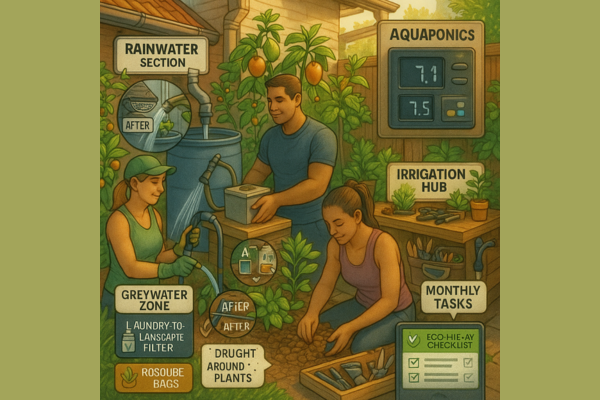
Maintaining and Optimizing Your Water System
A self-sufficient water system is only as reliable as its maintenance. Whether you’re harvesting rainwater, recycling greywater, or using aquaponics, regular care ensures efficiency, safety, and longevity. Here’s how to keep your system running smoothly year-round.
1. Regular Cleaning & Inspection
Rainwater Tanks & Storage
✔ Every 3-6 months:
- Check for debris in gutters and leaf screens.
- Inspect tank seals (prevent mosquitoes and contaminants).
- Clean sediment buildup at the bottom (use a sludge pump or flush valve).
✔ Annual deep clean:
- Drain and scrub tanks with a vinegar-water solution (avoid harsh chemicals).
- Check for cracks, algae growth, or leaks (especially in plastic tanks).
Greywater & Filtration Systems
- Weekly: Remove hair/clogs from sink/shower filters.
- Monthly: Flush branched drain pipes with white vinegar + baking soda.
- Bi-annually: Replace sand/charcoal filters in advanced systems.
Pro Tip: Install easy-access cleanouts in pipes to simplify maintenance.
2. Monitoring Water Quality
Preventing Algae & Bacterial Growth
- Rainwater:
- Keep tanks dark and opaque (sunlight encourages algae).
- Add mosquito dunks (Bti) if larvae appear (safe for plants).
- Aquaponics/Hydroponics:
- Test pH (6.5-7.5) and ammonia/nitrate levels weekly.
- Use beneficial bacteria (e.g., Bacillus subtilis) to outcompete pathogens.
- Greywater:
- Avoid standing water (breeds bacteria).
- Use plant-friendly soaps (no sodium or boron).
Test Kits for Urban Growers:
- JNW Direct Water Test Strips (checks pH, nitrates, hardness).
- Hanna Instruments Aquaponics Monitor (for advanced systems).
3. Seasonal Adjustments
Summer (Dry/Hot Climates)
- Increase mulch depth (4+ inches) to reduce evaporation.
- Adjust irrigation timers (water early morning/late evening).
- Shade tanks to keep water cool (prevents algae).
Winter (Freezing Risks)
- Drain exposed pipes (or use heat tape).
- Switch to frost-tolerant plants (kale, spinach) in greywater zones.
- Store rain barrels indoors if temperatures drop below freezing.
Rainy Seasons
- Divert excess rainwater to swales or infiltration pits.
- Bypass first-flush diverters if storms are frequent (to maximize storage).
4. Long-Term Optimization
- Upgrade components (e.g., replace vinyl tubing with UV-resistant PVC).
- Expand storage if you consistently run out of water.
- Track usage with a simple logbook or smart meter.
Signs Your System Needs Attention:
⚠ Foul odors (bacterial buildup).
⚠ Slow drainage (clogged filters/pipes).
⚠ Plant stress (yellowing, wilting) despite watering.
Conclusion: A System That Lasts
By spending just 1-2 hours per month on maintenance, your water system will stay efficient for decades. Pair these habits with seasonal tweaks, and you’ll build true water resilience in your urban permaculture space.
Final Tip: Label all pipes/tanks (e.g., “Greywater – Non-Potable”) for safety!
Building a Water-Wise Urban Oasis
Creating a self-sufficient water system for urban permaculture isn’t just about saving money or conserving resources—it’s about reclaiming independence in an unpredictable world. By harnessing rainwater, recycling greywater, and optimizing every drop, you transform your home into a resilient, eco-friendly hub that thrives even in droughts or water restrictions.
Key Strategies to Remember
- Harvest Rainwater – Capture free water from rooftops with simple barrels or advanced cisterns.
- Reuse Greywater – Redirect shower, laundry, and sink water to irrigate plants (safely!).
- Design for Retention – Swales, berms, and mulch lock moisture into the landscape.
- Go Soil-Less – Aquaponics and hydroponics grow more food with 90% less water.
- Irrigate Smartly – Drip systems + moisture sensors eliminate waste.
- Maintain Proactively – Clean tanks, test water, and adapt to seasons.
Start Small, Think Big
You don’t need a perfect system overnight. Begin with one rain barrel or a laundry-to-landscape setup, then expand as you learn. Every gallon saved is a step toward true sustainability.
Why This Matters
- Climate Resilience – Droughts and floods are increasing. Your system buffers against both.
- Food Security – Water independence means fresh harvests, even in crises.
- Community Impact – Imagine if every urban home conserved water—cities would transform.
Join the Movement
Your journey inspires others! Share your progress below:
- What’s working (or not) in your system?
- Need help troubleshooting? Ask away!
- Tag #UrbanWaterRevolution to connect with fellow permaculturists.


